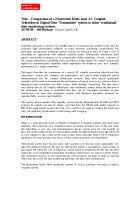Air Monitoring
Comparison of a Networked Multi-head AC Coupled Triboelectric Digital Dust ‘Transmitter’ system to other ‘traditional’ dust monitoring systems.
Oct 06 2014
Author: Jeff Hayhurst on behalf of CEM
ABSTRACT
Legislative pressure to monitor ever-smaller sources of emissions has resulted in the need for economic high performance solutions to many emission monitoring requirements. For particulate measurement traditional optical systems are proving to have too high a cost of ownership for applications with multiple emission points. Triboelectric instruments have gained considerable acceptance as an economically viable technology. Goyen, a pioneer of AC coupled triboelectric technology, have developed a totally digital AC coupled system with high-level communications capability which approaches the simplicity and ‘user -friendly' performance of a simple transmitter.
This paper describes the components of a typical AC coupled networked triboelectric dust ‘transmitter’ system and compares the performance and cost to both traditional optical instrumentation and DC coupled triboelectric systems. Data from typical application examples will be used to demonstrate the performance of typical systems e.g. emission from a municipal waste incinerator and filter system ‘break through’ monitoring. The data shows very clearly that an AC coupled triboelectric dust monitoring system where the function of the instruments has been so simplified that they can be reasonably described as dust transmitters, can more than adequately comply with European legislative demands for reproducibility, accuracy and reliability.
The system, which operates fully digitally, can be directly integrated into SCADA and DCS systems. Its outputs can also be simply converted from the RS485 half duplex network to RS232 for small simple systems allowing a low cost PC to be used to evaluate the results and carry out regulatory requirements of data storage and averaging.
INTRODUCTION
There is a clear growing desire on behalf of regulators to monitor medium and small sized industries dust emissions on a continuous basis. Economic pressures have in the past made this unrealistic as even low cost transmisometer opacity system were not ‘low enough’ in price and as the quality levels for dust dropped rapidly throughout Europe (typically below 20 or even 10mg/m3); they could not be used as their lower detection limit is 20 or 30mg/m3n depending of course and duct size and to a lesser extent on particle size distribution.
Triboelectric probes have become much more accepted over the last years, particularly ‘AC tribe’(the difference between DC and AC triboelectric probes is explained in a later section of this paper) but whilst the cost of obtaining a signal which is proportional to the dust has been reduce the cost of installation temperature including control boxes, AC power to all the heads, data acquisition systems etc has meant that the real saving has not been as large as expected when only the cost of the dust monitoring hardware was taken into consideration....
Digital Edition
IET 34.2 March 2024
April 2024
Gas Detection - Biogas batch fermentation system for laboratory use with automatic gas analysis in real time Water/Wastewater - Upcycling sensors for sustainable nature management - Prist...
View all digital editions
Events
Apr 24 2024 Jakarta, Indonesia
Apr 24 2024 Sao Paulo, Brasil
Apr 30 2024 Melbourne, Australia
Apr 30 2024 Birmingham, UK
May 03 2024 Seoul, South Korea















